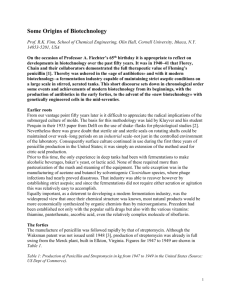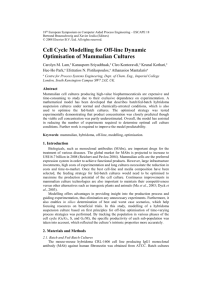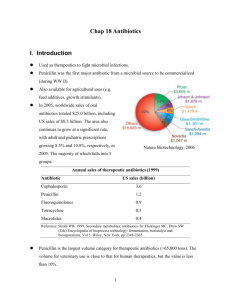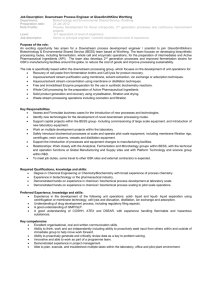1 Introduction to Fed-Batch Cultures
advertisement
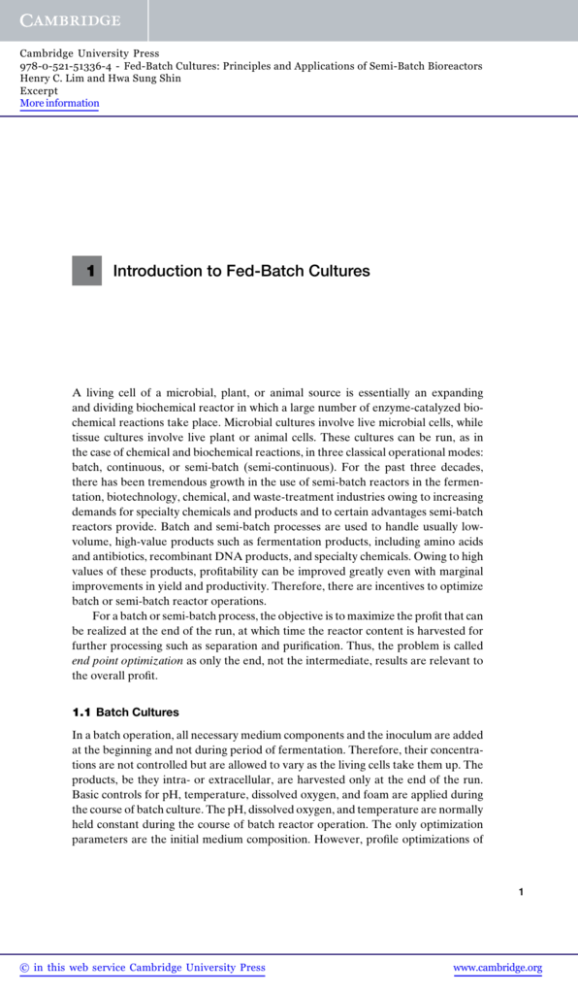
Cambridge University Press 978-0-521-51336-4 - Fed-Batch Cultures: Principles and Applications of Semi-Batch Bioreactors Henry C. Lim and Hwa Sung Shin Excerpt More information 1 Introduction to Fed-Batch Cultures A living cell of a microbial, plant, or animal source is essentially an expanding and dividing biochemical reactor in which a large number of enzyme-catalyzed biochemical reactions take place. Microbial cultures involve live microbial cells, while tissue cultures involve live plant or animal cells. These cultures can be run, as in the case of chemical and biochemical reactions, in three classical operational modes: batch, continuous, or semi-batch (semi-continuous). For the past three decades, there has been tremendous growth in the use of semi-batch reactors in the fermentation, biotechnology, chemical, and waste-treatment industries owing to increasing demands for specialty chemicals and products and to certain advantages semi-batch reactors provide. Batch and semi-batch processes are used to handle usually lowvolume, high-value products such as fermentation products, including amino acids and antibiotics, recombinant DNA products, and specialty chemicals. Owing to high values of these products, profitability can be improved greatly even with marginal improvements in yield and productivity. Therefore, there are incentives to optimize batch or semi-batch reactor operations. For a batch or semi-batch process, the objective is to maximize the profit that can be realized at the end of the run, at which time the reactor content is harvested for further processing such as separation and purification. Thus, the problem is called end point optimization as only the end, not the intermediate, results are relevant to the overall profit. 1.1 Batch Cultures In a batch operation, all necessary medium components and the inoculum are added at the beginning and not during period of fermentation. Therefore, their concentrations are not controlled but are allowed to vary as the living cells take them up. The products, be they intra- or extracellular, are harvested only at the end of the run. Basic controls for pH, temperature, dissolved oxygen, and foam are applied during the course of batch culture. The pH, dissolved oxygen, and temperature are normally held constant during the course of batch reactor operation. The only optimization parameters are the initial medium composition. However, profile optimizations of 1 © in this web service Cambridge University Press www.cambridge.org Cambridge University Press 978-0-521-51336-4 - Fed-Batch Cultures: Principles and Applications of Semi-Batch Bioreactors Henry C. Lim and Hwa Sung Shin Excerpt More information 2 Introduction to Fed-Batch Cultures temperature and pH may lead to improved performance over the operations carried out at constant temperature and constant pH. 1.2 Continuous Cultures In a continuous operation, one or more feed streams containing the necessary nutrients are fed continuously, while the effluent stream containing the cells, products, and residuals is continuously removed. A steady state is established by maintaining an equal volumetric flow rate for the feed and effluent streams. In so doing, the culture volume is kept constant, and all nutrient concentrations remain at constant steady state values. Continuous reactor operations are common in chemical industries. With the exception of single-cell protein production, certain beer production, and municipal waste treatment processes, continuous cultures have not been adopted widely by industry. It is not a dominant mode of industrial operation primarily because of the difficulty in maintaining sterility (contamination by other organisms) and protecting against phage attacks or mutations and because often, steady state operations are found to yield poorer results than dynamic operations, for reasons not yet fully understood. 1.3 Fed-Batch Cultures A fed-batch culture is a semi-batch operation in which the nutrients necessary for cell growth and product formation are fed either intermittently or continuously via one or more feed streams during the course of an otherwise batch operation. The culture broth is harvested usually only at the end of the operational period, either fully or partially (the remainder serving as the inoculum for the next repeated run). This process may be repeated (repeated fed-batch) a number of times if the cells are fully viable and productive. Thus, there are one or more feed streams but no effluent during the course of operation. Sources of carbon, nitrogen, phosphates, nutrients, precursors, or inducers are fed either intermittently or continuously into the culture by manipulating the feed rates during the run. The products are harvested only at the end of the run. Therefore, the culture volume increases during the course of operation until the volume is full. Thereafter, a batch mode of operation is used to attain the final results. Thus, the fed-batch culture is a dynamic operation. By manipulating the feed rates, the concentrations of limiting nutrients in the culture can be manipulated either to remain at a constant level or to follow a predetermined optimal profile until the culture volume reaches the maximum, and then a batch mode is used to provide a final touch. In so doing, the concentration of the desired product or the yield of product at the end of the run is maximized. This type of operation was first called a fed-batch culture or fed-batch fermentation.1,2 It is also known as Zulaufverfahren in German or ryukaho2 (a flow addition method) in Japanese. Obviously, this type of operation is a semi-batch reactor operation that is used for chemical and biochemical reactions. In environmental engineering dealing with toxic waste, this type of operation is known as a fill and draw operation or as a sequencing batch reactor. In biomedical engineering, the breathing process in and out of the lung is known as stick and balloon, as the volume of the lung increases as we inhale and decreases as we exhale, which is a form of fed-batch process. © in this web service Cambridge University Press www.cambridge.org Cambridge University Press 978-0-521-51336-4 - Fed-Batch Cultures: Principles and Applications of Semi-Batch Bioreactors Henry C. Lim and Hwa Sung Shin Excerpt More information 1.3 Fed-Batch Cultures 3 1.3.1 Reasons for Fed-Batch Cultures The fed-batch culture has been practiced since the early 1900s, when it was recognized in yeast production from malt wort that the malt concentration in the medium had to be kept low enough to suppress alcohol formation and maximize the yield3 of yeast cells. High malt concentration would accelerate the cell growth, which in turn would cause anaerobic conditions that favored ethanol formation and lowered the yield of yeast cells. Additional wort was added at a rate that was always less than the rate at which the yeast cells could use it. Intermittent or incremental feeding of nutrients to an initially dilute medium was introduced thereafter in large-scale yeast production to improve the yeast yields while obviating the production of ethanol.4 However, there is some speculation that a small amount of ethanol may be necessary to ensure the quality of the baker’s yeasts. Through the manipulation of one or more feed rates, the fed-batch operation can provide unique means of regulating the concentration of compounds that control the key reaction rates and, therefore, can provide a definite advantage over the batch or continuous operation. If it is advantageous to control independently the concentration of more than one species, more than one feed stream may be used. The fed-batch operation described previously can be also shown to yield a superior performance (a higher yield or higher productivity) for certain chemical and biochemical reactions that exhibit a maximum in the overall reaction rate or to maximize the selectivity of a specific product in systems of multiple reactions such as biological reactions and polymerization reactions. Examples include inhibited enzyme reactions and autocatalytic reactions, reactions in which one of the products acts as a catalyst, certain adiabatic reactions, and series parallel reactions. Fermentation and cell cultures are autocatalytic reactions in the sense that the cells produced are in turn producing additional cells, and it is not surprising to find that most of the industrially important fermentations are carried out in fed-batch mode. Extensive reviews of fed-batch techniques5–7,145,146 are available elsewhere. 1.3.2 Applications of Fed-Batch Cultures The oldest and first well-known industrial application of a fed-batch operation was introduced after the end of World War I. It was the yeast cell production in which sugar (glucose) was added incrementally during the course of fermentation to maintain a low sugar concentration to suppress alcohol formation.3 The manufacture of yeast by fed-batch culture has gone through a series of improvements and is an industrially important fed-batch process. This process was historically followed by penicillin fermentation, in which the energy source (e.g., glucose) and precursors (e.g., phenyl acetic acid) were added incrementally during the course of fermentation8 to improve penicillin production. Prior to this practice, a slowly metabolized but more expensive substrate, lactose, was used in place of glucose in a batch culture. Oversupply of a carbon source resulted in more mycelial growth and low penicillin formation, while undersupply resulted in slower mycelial growth and, eventually, slower penicillin formation. The most important questions to ask in fed-batch culture operations are what compounds(s) should be fed and how they should be added. The answers depend © in this web service Cambridge University Press www.cambridge.org Cambridge University Press 978-0-521-51336-4 - Fed-Batch Cultures: Principles and Applications of Semi-Batch Bioreactors Henry C. Lim and Hwa Sung Shin Excerpt More information 4 Introduction to Fed-Batch Cultures on the characteristics of the organisms used. The primary candidates in the list of compounds that may be fed during the course of the operation include the limiting substrate, inducers, precursors, a carbon source, a nitrogen source, a phosphate source, inducers, and other nutrient sources. The feeding patterns are open loop or feedback controlled to maintain some key variables at constant optimum values such as the specific growth rate, respiratory quotient, pH, partial pressure of carbon dioxide, dissolved oxygen, substrate concentration, and some metabolite concentrations. The optimum feed rates sometimes require keeping these parameters to follow certain optimum profiles rather than keeping them at constant values. To maximize the cell formation rate for the case of constant cell mass yield, it is obvious that the substrate concentration should be maintained at the value that maximizes the specific growth rate, Sm , until the reactor is full. Therefore, it is also obvious that the initial substrate concentration should be Sm , that is, S(0) = Sm , and that the substrate concentration should be maintained at Sm throughout the course of fermentation. This will lead to the maximum cell concentration at the end of the run. To achieve this, the feed rate must be regulated properly to hold the substrate concentration constant at Sm . If it is not possible to set the initial substrate concentration to Sm for one reason or another, the substrate concentration should be brought to this value as soon as possible by applying at the beginning the maximum substrate feed rate (S(0) < Sm ) or a batch period (S(0) > Sm ) and then regulating thereafter to maintain the substrate concentration to remain at Sm until the fermentor is full. Once the fermentor is full, it is run in a batch mode to reduce the substrate concentration to a desired level, and the cells containing the product are harvested. This is the basis for the simplest case of a fed-batch culture. Fed-batch cultures with the addition of nutrients, precursors, inducers, or other additives have been tested in laboratories, pilot plants, and industrial plants for production of various products2,5,6,7,9 such as yeasts; antibiotics; amino acids; fine organic acids; enzymes; alcoholic solvents; recombinant DNA products; proteins; tissue cultures, including hybridoma and Chinese hamster ovaries (CHO) cells; insect cell cultures; and others. These are listed in Table 1.1. 1.3.3 A Simple Example of a Fed-Batch Culture Let us consider a simple example to illustrate the advantage of controlling the concentration of the limiting nutrient. Consider the simplest case of growing cells, or a fermentation process in which the intracellular metabolite concentration is proportional to the cell concentration so that the metabolite production is maximized by maximizing the cell mass production. Assume that the specific growth rate of cells is substrate inhibited. In other words, the rate increases first with the substrate concentration reaching a maximum value of μm at the substrate concentration of Sm and then decreases with further increase in the substrate concentration. In other words, the rate is a nonmonotonic function of the substrate concentration, as shown in Figure 1.1. If the specific growth rate increases asymptotically with the substrate concentration to a maximum, as in the case of Monod-type monotonic kinetics, as shown in Figure 1.2, then it is obvious to keep the substrate concentration as high as possible to maximize the specific growth rate. Because the total growth rate is the product of © in this web service Cambridge University Press www.cambridge.org Cambridge University Press 978-0-521-51336-4 - Fed-Batch Cultures: Principles and Applications of Semi-Batch Bioreactors Henry C. Lim and Hwa Sung Shin Excerpt More information 1.3 Fed-Batch Cultures 5 Table 1.1. Various products produced or attempted to be produced by fed-batch techniques Product Amino Acids DOPA Glutamic Acid Lysine Tyrosine Tryptophan Alanine Antibiotics Candidin and candihexin Cephalosporin C Chlorotetracycline Griseofulvin Novobiocin Oxytetracycline Penicillin Rifamycin Streptomycin Tetracycline Thuringiensin Baker’s yeasts Enzymes Cellulase Galactosidase Isoamylase Penicillin amidase Polygalacturonic acid Trans-eliminase Protease β–amylase α–amylase β–Galactosidase β–Glucanase β–Glucosidase Microbial Cell Mass Bacteria A bacterium Cellulomonas sp. Protaminobact ruber Pseudomonas Pseudomonas AM-1 Yeasts Candida boidinii Candida brassicae Candida utilis Methylomonas L3 Pichia farinosa Pichia methanothermo Saccharomyces cerevisiae References 10, 148 11–23, 149 24, 25, 150, 151 25 26–28, 152 225 29 30–32, 153–155 33 34–36 37 38–39, 156 40–75, 157–158 76, 159–160 77–79, 161–162 80–81, 163 222 4, 82–91 Product Solvents Acetone and butanol Glycerol 1,3-Propanediol Vitamins Riboflavin Vitamin B12 Others Acetic acid Citric acid Gibberellic acid Gibberellins Neutral lipids Sorbose from sorbitol Others 5-Aminolevulinic acid (ALA) Monoclonal antibody Sophorolipid Polyhydroxyalkanoate (PHA) Dihydroxyacetone (DHA) Human interferon-γ 102–104, 178–180 Glutathione 105, 181 Clavulanic acid 182–187 Poly-β-hydroxybutyrate (PHB) 106–107, 188–191 108, 192–194 219 Animal Cell Culture Non-GS NS0 cell line 109 Hybridoma 110, 202 CHO 111, 112, 203 113, 204, 205 114, 206–208 92–96, 171–172 97, 173–174 98–99, 175–176 100, 177 101 References 125, 164–166 126, 167–168 123, 124 127–129, 169 130–133, 170 134, 195–196 135, 197–198 136, 199–201 137–140 141 142 216 217 218 220 221 223 224 226 227 230 228, 229, 231 232 115 116–118, 209 119–120, 210–211 212 121 122, 213 147, 214–215 © in this web service Cambridge University Press www.cambridge.org Cambridge University Press 978-0-521-51336-4 - Fed-Batch Cultures: Principles and Applications of Semi-Batch Bioreactors Henry C. Lim and Hwa Sung Shin Excerpt More information Specific Growth Rates, μ 6 Introduction to Fed-Batch Cultures µm Figure 1.1. Nonmonotonic specific growth rate. Sm Substrate Concentration, S the growth rate and fermentor volume, μXV , it is advantageous to have the largest working volume as possible from the start. In other words, a batch culture with a full working volume is the best for this situation. 1.4 Alternatives to Fed-Batch Cultures Specific Growth Rates, μ There are potential alternative operations. Why not run as a continuous culture with a proper dilution rate to maintain the substrate concentration at Sm , corresponding to the maximum specific growth rate? First, associated with a continuous culture is the problem of contamination by other microorganisms, attack by phages, and potential mutations over a long period of operation. In addition, the residual substrate concentration Sm may be substantial and may need to be further reduced for easier separation or a better yield. Therefore, an additional reactor is required to reduce the substrate concentration such as a batch or a large volume continuous fermentor. Also, there is evidence that the maximum production rate for some products can be achieved under a dynamic environment in which cells must continue to grow, however small it may be. For example, an attempt to replace the fed-batch fermentation by a continuous culture has not been successful for penicillin144 and bacterial antigens.145 Fed-batch cultures provide transient growth conditions for cells (oftentimes exponential growth of cells). Along this line of thought, it is well known that experimental kinetic data from one type of bioreactor may not be used to design another type of bioreactor, in particular, batch or fed-batch data may not be valid for continuous bioreactors, and vice versa. It is best to use experimental data obtained from the type of bioreactor that is to be used eventually to avoid this difficulty. This is presumed to be due to simplifying assumptions we make for a complex bioreactor. Figure 1.2. Monotonic specific growth rate, Monod type. Substrate Concentration, S © in this web service Cambridge University Press www.cambridge.org Cambridge University Press 978-0-521-51336-4 - Fed-Batch Cultures: Principles and Applications of Semi-Batch Bioreactors Henry C. Lim and Hwa Sung Shin Excerpt More information References 7 Conversely, chemical reactions are relatively simple in terms of our understanding, and therefore, the kinetic data obtained from one type of chemical reactor usually hold for any other type of reactor. REFERENCES 1. Burrows, S. 1970. Baker’s yeast, in The Yeast, vol. 3, ed. Rose, A. S., and Harrison, J. S., p. 350. Academic Press. 2. Yamane, T. 1978. Kinetic studies on fed-batch fermentations: A monograph. Hakko Kogaku Kaishi 56: 310–322. 3. White, J. 1954. Yeast Technology. Vol. 31. John Wiley. 4. Reed, G., and Peppler, H. J. 1973. Yeast Technology. Avi. 5. Yamane, T., and Shimizu, S. 1984. Fed-batch techniques in microbial processes. Advances in Biochemical Engineering/Biotechnology 30: 147–202. 6. Parelukar, S., and Lim, H. 1986. Modeling, optimization and control of semi- 7. 8. 9. 10. 11. 12. 13. 14. 15. 16. 17. 18. 19. 20. batch bioreactors. Advances in Biochemical Engineering/Biotechnology 32: 1207–1258. Minihane, B. J., and Brown, D. E. 1986. Fed-batch culture technology. Biotechnology Advances 4: 207–218. Hosler, P., and Johnson, M. J. 1953. Penicillin from chemically defined media. Industrial and Engineering Chemistry 45: 871–874. Whitaker, A. 1980. Fed-batch culture. Process Biochemistry 15: 10–12, 14–15, 32. Yamada, H., Kumagai, J., Enei, H., Matsui, H., and Okumura, S. 1972. Microbiological synthesis of L-tyrosine and 3,4-dihydroxyphenyl-L-alanine, in Fermentation Technology Today, ed. Terui, G., p. 445. Society for Fermentation Technology. Nakamura, T., Kuratani, T., and Morita, Y. 1985. Fuzzy control application to glutamic acid fermentation. Proceedings of IFAC Modeling and Control of Biotechnology Processes Noordwijkerhout, The Netherlands, December. Tsao, J. H., Chaung, H. L., and Wu, W. T. 1991. On-line state estimation and control in glutamic acid production. Bioprocess Biosystem Engineering 7: 35–39. Su, Y. C., and Yamada, K. 1960. Studies on L-glutamic acid fermentation. Part III. Pilot plant scale test of the fermentative production of L-glutamic acid by Brevibacterium divaricatum nov. sp. Bulletin Agricultural Chemistry Society Japan 24: 525–529. Kishimoto, M., Alfafara, C. G., Nakajima, M., Yoshida, T., and Taguchi, H. 1989. The use of the maharanobis and modified distances for the improvement of simulation of glutamic acid production. Biotechnology and Bioengineering 33: 191–196. Kishimoto, M., Moo-Young, M., and Allsop, P. 1991. A fuzzy expert system for the optimization of glutamic acid production. Bioprocess Engineering 6: 173–177. Kishimoto, M., Kitta, Y., Takeuchi, S., Nakajima, M., and Yoshida, T. 1991. Computer control of glutamic acid production based on fuzzy clusterization of culture phases. Journal of Fermentation and Bioengineering 72: 110–114. Wu, J. Y., and Wu, W. T. 1992. Glutamic acid production in an airlift reactor with net draft tube. Bioprocess Engineering 8: 183–187. Sanraku Ocean Company Ltd and Ajinomoto Company Ltd. 1968. French Patent 1,556,808. Tanaka, K., and Kimura K. 1970. Method for producing L-glutamic acid. U.S. Patent 3,511,752. Yamamoto, M., Nishida, H., Inui, T., and Ozaki, A. 1972. Microbial production of amino acids from aromatic compounds. II. Production of L-glutamic acid from benzoate. Hakko Kogaku Zasshi 50: 876–883. © in this web service Cambridge University Press www.cambridge.org Cambridge University Press 978-0-521-51336-4 - Fed-Batch Cultures: Principles and Applications of Semi-Batch Bioreactors Henry C. Lim and Hwa Sung Shin Excerpt More information 8 Introduction to Fed-Batch Cultures 21. Yamamoto, M., Nishida, H., Inui, T., and Ozaki, A. 1972. Microbial production 22. 23. 24. 25. 26. 27. 28. 29. 30. 31. 32. 33. 34. 35. 36. 37. 38. 39. 40. 41. 42. of amino acids from aromatic compounds. III. Metabolic pathway of benzoate utilized by Brevibacterium species No. 6, a typical L-glutamate producer. Hakko Kogaku Zasshi 50: 884–892. Kishimoto, M., Yoshida, T., and Taguchi, H. 1981. Simulation of fed-batch culture for glutamic acid production with ethanol feeding by use of regression analysis. Journal of Fermentation Technology 59: 43–48. Kishimoto, M., Yoshida, T., and Taguchi, H. 1981. On-line optimal control of fedbatch culture of glutamic acid production. Journal of Fermentation Technology 59: 125–129. Fr. Demande (Kyowa Fermentation Industries Company Ltd). 1969. Bacterial production of L-lysine. U.S. Patent 3,595,751. Ohno, H., Nakanishi, F., and Takamatsu, T. 1976. Optimal control of a semibatch fermentation. Biotechnology and Bioengineering 18: 847–864. Ikeda, M., and Katsumata, R. 1999. Hyperproduction of tryptophan by Corynebacterium glutamicum with the modified pentose phosphate pathway. Applied Environmental Microbiology 65: 2497–2502. Aiba, S., Imanaka, T., and Tsunekawa, H. 1980. Enhancement of tryptophan production by Escherichia coli as an application of genetic engineering. Biotechnology Letters 2: 525–532. Aiba, S., Tsunekawa, H., and Imanaka, T. 1982. New approach to tryptophan production by Escherichia coli: Genetic manipulation of composite plasmids in vitro. Applied Environmental Microbiology 43: 289–297. Martin, J. F., and McDaniel, L. E. 1974. Submerged culture production of the polyene antifungal antibiotics candidin and candihexin. Developments in Industrial Microbiology 15: 324–337. Pirt, S. J. 1974. The theory of fed-batch culture with reference to the penicillin fermentation. Journal of Applied Chemistry and Biotechnology 24: 415–424. Trilli, A., Michelini, V., Mantovani, V., and Pirt, S. J. 1977. Estimation of productivities in repeated fed batch cephalosporin fermentation. Journal of Applied Chemistry and Biotechnology 27: 219–224. Matsumura, M., Imanaka, T., Yoshida, T., and Taguchi, T. 1981. Modeling of cephalosporin C production and its application to fed-batch culture. Journal of Fermentation Technology 59: 115–123. Avanzini, F. 1963. Preparation of tetracycline antibiotics. British Patent 939,476. Hockenhull, D. J. D. 1959. Griseofulvin. British Patent 868,958. Hockenhull, D. J. D. 1962. Griseofulvin in submerged aerobic culture. British Patent 934,527. Calam, C. T., Ellis, S. H., and McCann, M. J. 1971. Mathematical models of fermentations and a simulation of the griseofulvin fermentation. Journal of Applied Chemistry and Biotechnology 21: 181–189. Smith, C. G. 1956. Fermentation studies with Streptomyces niveus. Applied Microbiology 4: 232–236. Bosnjak, M., Stroj, A., Curcic, M., Adamovic, V., Gluncic, Z., and Bravar, D. 1985. Application of scale-down experiments in the study of kinetics of oxytetracycline biosynthesis. Biotechnology and Bioengineering 27: 398–408. Ettler, P. 1987. Oil feeding during the oxytetracycline biosynthesis. Acta Biotechnologie 7: 3–8. Johnson, M. J. 1952. Recent advances in penicillin fermentation. Bulletin of the World Health Organization 6: 99–121. Moyer, A., and Coghill, R. D. 1946. Penicillin: VIII. Production of penicillin in surface cultures. Journal of Bacteriology 51: 57–78. Singh, K., and Johnson, M. J. 1948. Evaluation of the precursors for penicillin G. Journal of Bacteriology 56: 339–355. © in this web service Cambridge University Press www.cambridge.org Cambridge University Press 978-0-521-51336-4 - Fed-Batch Cultures: Principles and Applications of Semi-Batch Bioreactors Henry C. Lim and Hwa Sung Shin Excerpt More information References 9 43. Coghill, R. D., and Moyer, A. J. 1947. Production of increased yields of penicillin. U.S. Patent 2,423,873. 44. Brown, W. E., and Peterson, W. H. 1950. Factors affecting production of peni- 45. 46. 47. 48. 49. 50. 51. 52. 53. 54. 55. 56. 57. 58. 59. 60. 61. 62. 63. 64. cillin in semi-pilot-plant equipment. Industrial and Engineering Chemistry 42: 1769–1775. Brown, W. E., and Peterson, W. H. 1950. Penicillin fermentations in a Waldhoftype fermenter. Industrial and Engineering Chemistry 42: 1823–1826. Foster, J. W., and McDaniel, L. E. 1952. Fermentation process. U.S. Patent 2,584,009. Owen, S. P., and Johnson, M. J. 1955. Effect of temperature changes on the production of penicillin by Penicillium chrysogenum. Applied Microbiology 3: 375–379. Kolachov, P. J., and Schneider, W. C. 1952. Continuous process for penicillin production. U.S. Patent 2,609,327. Soltero, F. V., and Johnson, M. 1953. The effect of the carbohydrate nutrition on penicillin production by Penicillium chrysogenum Q-176. Applied Microbiology 1: 52–57. Davey, V. F., and Johnson, M. 1953. Penicillin production in corn steep media with continuous carbohydrate addition. Applied Microbiology 1: 208–211. Anderson, R. F., Whitmore, L. M. J., Brown, W. E., Peterson, W. H., Churchill, B. W., Roegner, F. R., Campbell, T. H., Backus, M. P., and Stauffer, J. F. 1953. Penicillin production by pigment-free molds. Industrial and Engineering Chemistry 45: 768–773. Soltero, F. V., and Johnson, M. J. 1954. Continuous addition of glucose for evaluation of penicillin-producing cultures. Applied Microbiology 2: 41–44. Anderson, R. F., Tornqvist, E. G. M., and Peterson, W. H. 1956. Effect of oil in pilot plant fermentations for penicillin production. Journal of Agricultural Food Chemistry 4: 556–559. Freaney, T. E. 1958. Penicillin. U.S. Patent 2,830,934. Pan, S. C., Bonanno, S., and Wagman, G. H. 1959. Efficient utilization of fatty oils as energy source in penicillin fermentation. Applied Microbiology 7: 176– 180. Tornqvist, E. G. M., and Peterson, W. H. 1956. Penicillin production by highyielding strains of Penicillium chrysogenum. Applied Microbiology 4: 277–283. Chaturbhuj, K., Gopalkrishnan, K. S., and Ghosh, D. 1961. Studies on the feed rate for precursor and sugar in penicillin fermentation. Hindustan Antibiotic Bulletin 3: 144–151. Chaturbhuj, K., and Ghosh, D. 1961. Semi-continuous penicillin fermentation. Hindustan Antibiotic Bulletin 4: 50–51. Hockenhull, D. J. D., and Mackenzie, R. M. 1968. Preset nutrient feeds for penicillin fermentation on defined media. Chemistry and Industry 19: 607–610. Noguchi, Y., Kurihara, S., and Arao, O. 1960. Influence of feeding of nitrogen source on the penicillin production. Hakko Kogaku Zasshi 38: 514–517. McCann, E. P., and Calam, C. T. 1972. Metabolism of Penicillium chrysogenum and the production of penicillin using a high yielding strain, at different temperatures. Journal of Applied Chemistry and Biotechnology 22: 1201–1208. Matelova, V., Brecka, A., and Matouskova, J. 1972. New method of intermittent feeding in penicillin biosynthesis. Applied Microbiology 23: 669–670. Pan, C. H., Hepler, L., and Elander, R. P. 1972. Control of pH and carbohydrate addition in the penicillin fermentation. Developments in Industrial Microbiology 13: 103–112. Fishman, V. M., and Birokov, V. V. 1974. Kinetic model of secondary metabolite production and its use in computation of optimal conditions. Biotechnology and Bioengineering Symposium 4: 647–662. © in this web service Cambridge University Press www.cambridge.org Cambridge University Press 978-0-521-51336-4 - Fed-Batch Cultures: Principles and Applications of Semi-Batch Bioreactors Henry C. Lim and Hwa Sung Shin Excerpt More information 10 Introduction to Fed-Batch Cultures 65. Verkhovtseva, T. P., Lur’e, L. M., Itsygin, S. B., Stepanova, N. E., and Levi- 66. 67. 68. 69. 70. 71. 72. 73. 74. 75. 76. 77. 78. 79. 80. 81. 82. 83. 84. 85. tov, M. M. 1975. Carbon metabolism under conditions of controlled penicillin biosynthesis. Antibiotiki 20: 102–106. Noguchi, Y., Miyakawa, R., and Arao, O. 1960. Penicillin fermentation: Relation of the amount of glucose and soybean oil added and the potency of the culture in the fermentation by feeding technique. Journal of Fermentation Technology 38: 511–514. Rodrigues, J. A. D., and Maciel Filho, R. 1999. Production optimization with operating constraints for a fed-batch reactor with DMC predictive control. Chemica Engineering Science 54: 2745–2751. Badino, A. C., Jr., Barboza, M., and Hokka, C. O. 1994. Power input and oxygen transfer in fed-batch penicillin production process. Advances in Bioprocess Engineering , Kluwer Academic Publishers, 157–162. Menezes, J. C., Alves, S. S., Lemos, J. M., and Feyo de Azevedo, S. 1994. Mathematical modeling of industrial pilot-plant penicillin-G fed-batch fermentations. Journal of Chemical Technology and Biotechnology 61: 123–138. Nicolai, B. M., Van Impe, J. F., Vanrolleghem, P. A., and Vandewalle, J. 1991. A modified unstructured mathematical model for the penicillin G fed-batch fermentation. Biotechnology Letters 13: 489–494. Squires, R. W. 1972. Regulation of the penicillin fermentation by means of a submerged oxygen-sensitive electrode. Developments in Industrial Microbiology 13: 128–135. Calam, C. T., and Russell, D. W. 1973. Microbial aspects of fermentation process development. Journal of Applied Chemistry and Biotechnology 23: 225–237. Moyer, A. J., and Coghill, R. D. 1947. Penicillin. X. The effect of phenylacetic acid on penicillin production. Journal of Bacteriology 53: 329–341. Hegewald, E., Wolleschensky, B., Guthke, R., Neubert, M., and Knorre, W. A. 1981. Instabilities of product formation in a fed-batch culture of Penicillium chrysogenum. Biotechnology and Bioengineering 23: 1563–1572. Mou, D.-G., and Cooney, C. L. 1983. Growth monitoring and control through computer-aided on-line mass balancing in a fed-batch penicillin fermentation. Biotechnology and Bioengineering 25: 225–255. Bapat, P. M., Padiyar, N. U., Dave, N. N., Bhartiya, S., and Wangikar, P. P. 2006. Model-based optimization of feeding recipe for rifamycin fermentation. Journal of American Institute of Chemical Engineers 52: 4248–4257. Singh, A., Bruzelius, E., and Heding, H. 1976. Streptomycin: A fermentation study. European Journal of Applied Microbiology 3: 97–101. Jackson, C. J., and Milner, J. 1950. Improvements in the production of streptomycin. British Patent 644,078. Inoue, S., Nishizawa, Y., and Nagai, S. 1983. Stimulatory effect of ammonium on streptomycin formation by Streptomyces griseus growing on a glucose minimal medium. Journal of Fermentation Technology 61: 7–12. Avanzith, F. 1963. Preparation of tetracycline antibiotics. British Patent 939,476. Makarevich, V. G., Slugina, M. D., Upiter, G. D., Zaslavskaia, P. L., and Gerasimova, T. M. 1976. Regulation of tetracycline biosynthesis by controlling the growth of the producer. Antibiotiki 21: 205–210. Wang, H. Y., Cooney, C. L., and Wang, D. I. C. 1979. Computer control of bakers’ yeast production. Biotechnology and Bioengineering 21: 975–995. Finn, B., Harvey, L., and McNeil, B. 2006. Near-infrared spectroscopic monitoring of biomass, glucose, ethanol and protein content in a high cell density baker’s yeast fed-batch bioprocess. Yeast 23: 507–517. Hospodka, J. 1966. Oxygen-absorption rate-controlled feeding of substrate into aerobic microbial cultures. Biotechnology and Bioengineering 8: 117–134. Mikiewicz, T., Leniak, W., and Ziobrowski, J. 1975. Control of nutrient supply in yeast propagation. Biotechnology and Bioengineering 17: 1829–1832. © in this web service Cambridge University Press www.cambridge.org
